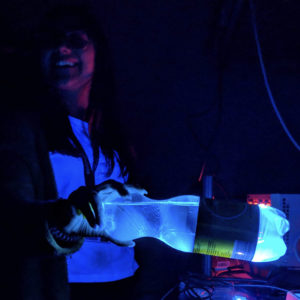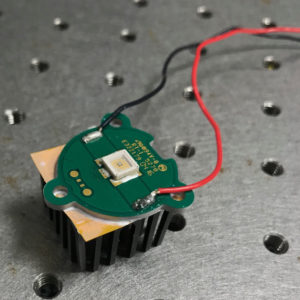A PhD project investigating 280 nm LEDs in biomedical optical imaging
Deep-UV LEDs have many potential applications in biomedical science. Together with Medical Research Scotland, CoolLED sponsors a PhD project on this topic in Professor Gail McConnell’s research group, in the department of Physics at the University of Strathclyde.
In this interview, PhD student Mollie McFarlane tells us about her project and recently published paper which introduces a fluorescence-based method for characterising deep-UV LEDs.
Tell us about yourself
I came to Strathclyde to study for a degree in physics. My first introduction to the biological side of physics was my undergraduate project with the Photophysics Group, where I developed gold nanorod-based biosensors for cancer detection in blood samples.
The nanoparticle synthesis was my favourite aspect, and I’m hoping I’ll get to do some quantum dot synthesis soon. It also gave me a good background for my PhD. I wasn’t 100% sure whether to do a PhD, but when I saw this project, I thought if I’m going to do one it has to be this one because it was so relevant to my previous studies.
The research group I’m now part of is quite unique in the fact we belong to the Physics department and are based within the Pharmacy and Biomedical Sciences building. Our group contains a mixture of people with backgrounds in biology and physics. There is a lot of diverse work going on around both departments, and we are really strong in biophysics.
What’s your PhD all about?
The main goal of my PhD is to find the best way of integrating a 280 nm LED into a fluorescence microscope and explore its applications. Usually with a visible spectrum LED we just use the epifluorescence port, but with deep-UV LEDs it’s not so simple. UV transmits very poorly through glass, so it’s very difficult to get any UV light to the sample. I also want to investigate the potential applications for biomedical imaging. The 280 nm wavelength has been used before in label-free imaging applications, and it overlaps with the excitation spectrum of amino acids tryptophan and tyrosine, which autofluoresce.1 There is also the technique known as microscopy with ultraviolet surface excitation (MUSE), which uses 280 nm to image the surface of tissue.2 I’d like to investigate the impact of this wavelength on cells. Can cells withstand this radiation and for how long can we image? I’m particularly interested in nanotechnology, so I’m hoping to bring this into the project by using quantum dots as fluorescent labels. These have a lot of advantages over standard fluorophores. I’m hoping I can demonstrate an advantage in using this lower wavelength in live cells and maybe an increased resolution which can be exploited for biomedical applications.
What does your research paper explain?
Characterising deep-UV LEDs previously involved a lot of specialised, expensive equipment, which was the main issue: you’d need a UV-extended integrating sphere/spectrometer and a camera that can detect in the UV. I found the most accessible way to characterise the emission pattern of a deep-UV LED was to use fluorescence to convert the UV light into visible light so it could be detected by a standard camera. I did this using a block of agarose embedded with fluorescein because it has quite a broad excitation spectrum. There is no specialist or expensive equipment required: just an objective lens, a couple of tube lenses and a CMOS camera.

What do you enjoy most about your work?
My favourite part is building microscopes, because I really enjoy doing hands-on research, whether it’s building or synthesising something in the lab. It’s like following a recipe. I built a microscope from scratch last year and when you switch it on for the first time and look at a sample, it’s so exciting – to think that I made this!
How has industry collaboration helped?
One of the things that drew me to this project was the fact it’s an industry partnership and you don’t get that often. I’m learning a lot from CoolLED that I wouldn’t learn at university, I’m also looking forward to visiting CoolLED again and learning about other aspects of the business, like manufacturing. During my first visit to CoolLED, I had only just started working with LEDs. Luther (one of CoolLED’s mechanical design engineers) was so helpful, he taught me how to put together an LED package from a bare die which involved soldering on wires and heatsinking, and I still use those techniques now. Alex (Optical Engineer) and Gerry (Technical Director) helped me to measure the electroluminescence spectrum of the LED myself, and showed me how to use Zemax, the optical modelling software, so I’ve done a bit of work using that as part of my project. We have quarterly catch-up calls and Gerry always has some really helpful suggestions for any problems that I have.

What advice would you have for someone choosing a PhD?
If I didn’t do so much research in my undergraduate project and summer internship, I think I’d struggle going straight from undergraduate studies to a PhD, as to me it’s very different. You have to structure your own time and you’re in charge of your own research.
When you’re choosing a project, try and get to know your potential supervisor and research group because as well as having an interest in the project, your work environment is really important as well. Sometimes doing a PhD can be quite isolating, but I’m really lucky that my group are also my friends, and I’d struggle without that support network.
What are the next steps in your project?
Now I’ve finished the characterisation part, I’m looking at integrating the 280 nm LED into the microscope. I’d also ideally like the method to be compatible with standing wave microscopy, which is a method to increase the axial resolution, which we do a lot of work on in my group. So once I find the best way to illuminate my sample, I’d like to find out which dyes work best with the LED. Then I’d like to investigate how cells cope with the 280 nm radiation and see what the benefits are of using deep-UV.

